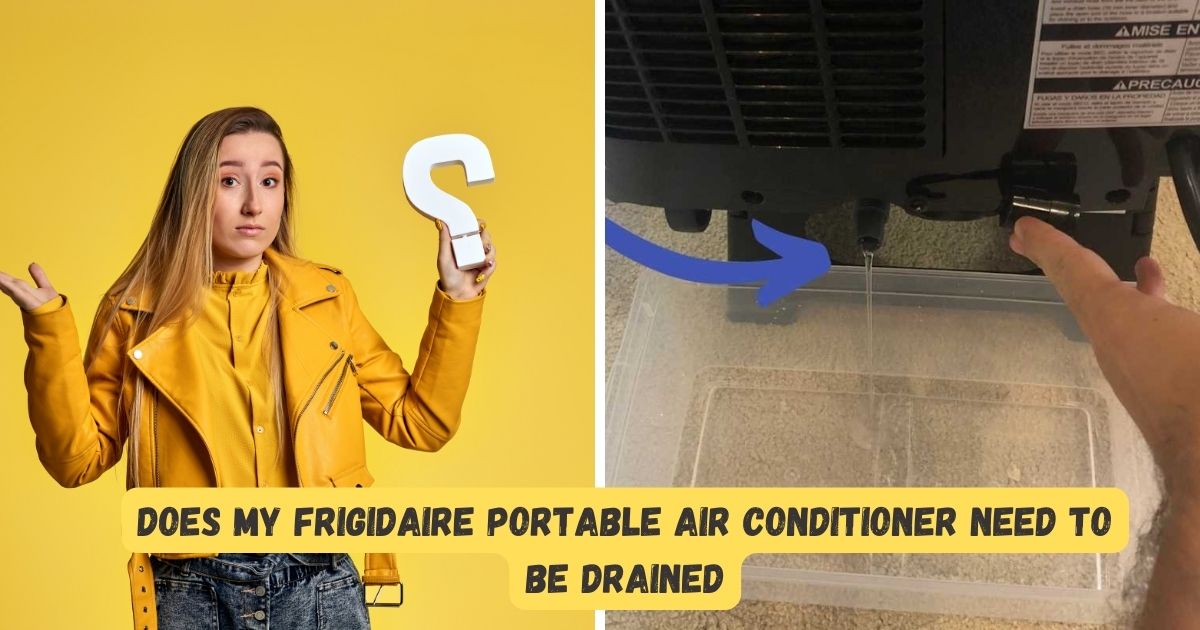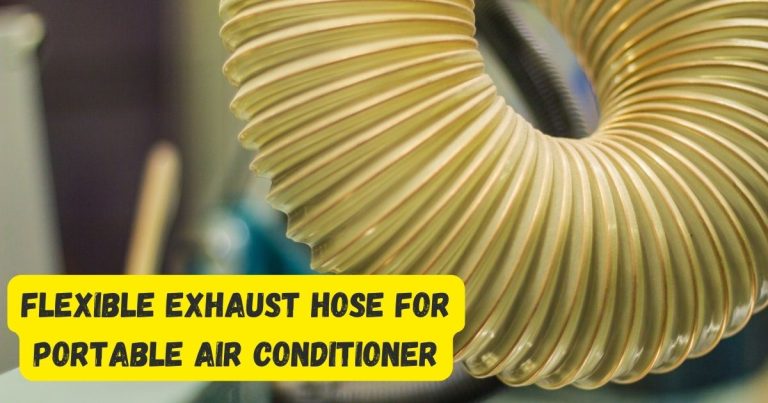Does My Frigidaire Portable Air Conditioner Need To Be Drained? Find Out Here
Yes, your Frigidaire portable air conditioner needs to be drained. Portable air conditioners typically collect moisture from the air during operation, and this water needs to be drained periodically to prevent the unit from overflowing or becoming damaged. Regularly checking and emptying the condensate tank or using a continuous drain setup is recommended to ensure optimal performance and prevent any issues.
Are you the proud owner of a Frigidaire portable air conditioner? If so, you’re likely well aware of the comfort and convenience it brings to your space. But, like any appliance, it’s essential to understand its maintenance requirements to ensure optimal performance.
One question that may have crossed your mind is whether your Frigidaire portable air conditioner needs to be drained. This seemingly simple question can have significant implications for the efficiency and lifespan of your unit.
In this blog article, we will delve into the world of Frigidaire portable air conditioners and answer the burning question of whether or not they require draining. We understand that uncertainty around this topic can lead to potential damage or inefficiency if not addressed correctly. That’s why we’re here to provide you with the knowledge and clarity you need to keep your air conditioner running smoothly.
Throughout this article, we will explore the key factors that determine whether your Frigidaire portable air conditioner requires draining. We’ll discuss the inner workings of your unit, look at common misconceptions, and provide practical tips for maintaining its optimal performance. By the end, you will have a clear understanding of whether or not your Frigidaire portable air conditioner needs to be drained, empowering you to make informed decisions and ensure the longevity of your appliance.

Understanding the Mechanics of a Frigidaire Portable Air Conditioner
Before we dive into the question of whether or not your Frigidaire portable air conditioner needs to be drained, it’s important to first understand how these units work. Portable air conditioners, including those manufactured by Frigidaire, operate using a similar principle as their larger, fixed counterparts.
A portable air conditioner works by extracting heat and moisture from the air in your space. It does this through a refrigeration cycle that consists of four main components: a compressor, a condenser, an expansion valve, and an evaporator. These components work in harmony to cool the air and remove excess moisture.
The compressor pressurizes and circulates the refrigerant, which is responsible for absorbing heat from the air. The heated refrigerant moves to the condenser, where it releases the absorbed heat to the surrounding environment. As the refrigerant cools down, it transitions to a liquid state and flows through the expansion valve.
The expansion valve acts as a restriction, causing the refrigerant to expand rapidly. This expansion leads to a drop in pressure and temperature, allowing the refrigerant to absorb more heat from the air. Finally, the refrigerant flows into the evaporator, a coil that is cooled by a fan. As warm air from your space passes over the evaporator coil, the refrigerant absorbs the heat, causing the air to cool down.
As the air is cooled, the moisture in the air condenses on the evaporator coil and collects in a drip pan or tray. This is where the drainage question comes into play – what happens to this accumulated moisture?
Understanding Moisture Removal in a Frigidaire Portable Air Conditioner
The process of removing moisture from the air is an essential component of any air conditioning unit. Excess humidity can lead to discomfort, promote the growth of mold and mildew, and hinder the cooling process. Frigidaire portable air conditioners are designed to effectively remove moisture from the air, improving overall comfort and air quality.
In most cases, the moisture extracted from the air during the cooling process is evaporated back into the atmosphere through a clever mechanism known as “auto evaporation.” This means that the majority of Frigidaire portable air conditioners do not require manual drainage.
Auto evaporation works by utilizing the warm air expelled from the unit’s condenser to evaporate the collected moisture in the drip pan or tray. The hot air, which contains the moisture, is redirected over the condenser coil, where it helps cool the coil and facilitate the evaporation process.
This self-evaporation feature is convenient for users, as it eliminates the need for constant monitoring and emptying of a separate water tank or reservoir. It also prevents the accumulation of stagnant water, which can lead to unpleasant odors and potential bacterial growth.
Exceptions and Special Considerations
While most Frigidaire portable air conditioners feature auto evaporation, there are some exceptions and special considerations to keep in mind. Certain scenarios may require manual drainage or the use of an external drainage option.
High Humidity Environments
In excessively humid environments, the auto evaporation feature may not be sufficient to handle the high levels of moisture. This can occur in regions with consistently high humidity or during periods of extreme weather conditions.
If you find that your Frigidaire portable air conditioner is unable to effectively evaporate the collected moisture, it may be necessary to manually drain the water. Consult your unit’s user manual or contact Frigidaire’s customer support for guidance on how to safely drain the water.
Extended Continuous Operation
Another situation that may require manual drainage is when the portable air conditioner is operated continuously for an extended period. In such cases, the auto evaporation feature may struggle to keep up with the constant moisture extraction.
If you intend to run your Frigidaire portable air conditioner continuously for several days or weeks, it’s recommended to check the drip pan or tray regularly. If you notice excessive moisture accumulation, consult the user manual or contact Frigidaire for guidance on draining the water.
Maintaining Your Frigidaire Portable Air Conditioner
Proper maintenance is crucial to ensure the longevity and efficient operation of your Frigidaire portable air conditioner. By following these practical tips, you can optimize its performance and avoid potential drainage issues:
Clean the Air Filter
The air filter in your Frigidaire portable air conditioner plays a vital role in maintaining good air quality and preventing clogs in the system. Regularly cleaning or replacing the air filter is essential for optimal performance.
Consult your unit’s user manual for instructions on how to remove and clean the air filter. Depending on the model, the filter may be washable or require replacement. Aim to clean or replace the filter at least once every two weeks or as recommended by the manufacturer.
Maintain Proper Ventilation
Proper ventilation is crucial for the efficient operation of any air conditioning unit, including portable models. Ensure that the exhaust hose is securely connected to both the air conditioner and the window kit.
Avoid kinks or bends in the exhaust hose that may restrict airflow. If necessary, use an insulating seal or tape to minimize air leaks around the window kit. This will help maintain the cooling efficiency of your Frigidaire portable air conditioner.
Keep the Unit Level
Avoid placing your Frigidaire portable air conditioner on an uneven surface. It’s important to ensure that the unit is level to prevent any excessive condensation accumulation or drainage issues.
If necessary, use shims or a leveling tool to adjust the unit’s position. This will help facilitate proper drainage and prevent any water from pooling in the wrong areas of the unit.
Regularly Inspect and Clean the Drip Pan/Tray
Even though most Frigidaire portable air conditioners feature auto evaporation, it’s essential to periodically inspect and clean the drip pan or tray. Over time, dust, debris, or other particles may accumulate and hinder the evaporation process.
Refer to the user manual for instructions on how to access the drip pan or tray. Clean it thoroughly using mild soap and water, ensuring that any obstructions or build-up are removed. This will help maintain efficient moisture evaporation and prevent any potential drainage issues.
The Final Verdict: Does Your Frigidaire Portable Air Conditioner Need to be Drained?
After exploring the inner workings of Frigidaire portable air conditioners and the moisture removal process, it’s time to answer the burning question – does your unit need to be drained?
In most cases, the answer is no. The majority of Frigidaire portable air conditioners feature auto evaporation, which effectively evaporates the collected moisture. This eliminates the need for manual drainage and simplifies the maintenance process for users.
However, there are exceptions to keep in mind. In high humidity environments or during extended periods of continuous operation, manual drainage may be necessary if the auto evaporation feature is overwhelmed.
To ensure optimal performance, it’s important to follow regular maintenance practices, such as cleaning the air filter, maintaining proper ventilation, keeping the unit level, and inspecting/cleaning the drip pan or tray. These steps will help prevent any potential drainage issues and allow your Frigidaire portable air conditioner to function efficiently throughout its lifespan.
By understanding the mechanics of your Frigidaire portable air conditioner and implementing the necessary maintenance steps, you can enjoy cool, comfortable air without the worry of drainage-related problems.
Portable Air Conditioners – Why you shouldn’t like them
Frequently Asked Questions (FAQ)
1. Does my Frigidaire portable air conditioner need to be drained?
2. How often should I drain my Frigidaire portable air conditioner?
3. What happens if I don’t drain my Frigidaire portable air conditioner?
4. How do I drain my Frigidaire portable air conditioner?
5. Can I use a hose to drain my Frigidaire portable air conditioner?
Final Summary: Maintaining Your Frigidaire Portable Air Conditioner for Optimal Performance.
In conclusion, understanding the mechanics of a Frigidaire portable air conditioner is essential in determining whether or not it needs to be drained. These units operate by extracting heat and moisture from the air through a refrigeration cycle.
Most Frigidaire portable air conditioners feature an auto evaporation feature, which effectively evaporates the collected moisture, eliminating the need for manual drainage in most cases. This is achieved by redirecting the warm air expelled from the condenser over the drip pan or tray, facilitating the evaporation process.
However, there are exceptions to consider. In high humidity environments or during extended periods of continuous operation, the auto evaporation feature may be overwhelmed and manual drainage may be necessary. In such cases, it is important to consult the unit’s user manual or contact Frigidaire’s customer support for guidance on safely draining the water.
To maintain the optimal performance of your Frigidaire portable air conditioner, it is crucial to follow proper maintenance practices. This includes cleaning or replacing the air filter regularly, maintaining proper ventilation by ensuring a secure connection of the exhaust hose, keeping the unit level to facilitate proper drainage, and periodically inspecting and cleaning the drip pan or tray to prevent obstructions or build-up. By understanding the mechanics of your Frigidaire portable air conditioner and implementing these maintenance steps, you can ensure that your unit operates efficiently and avoids any potential drainage issues.






